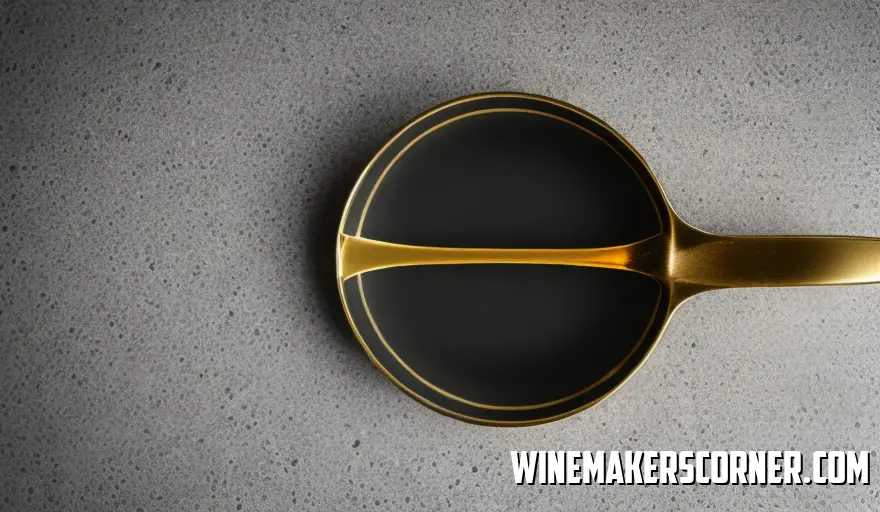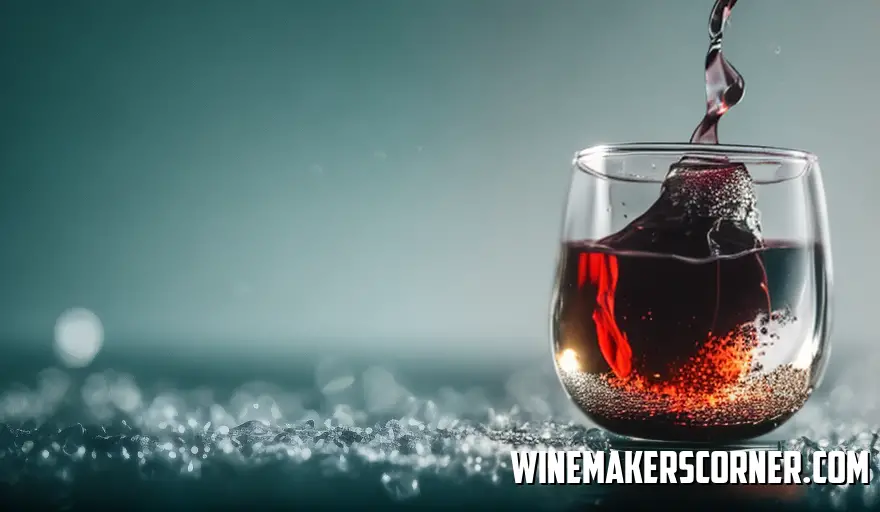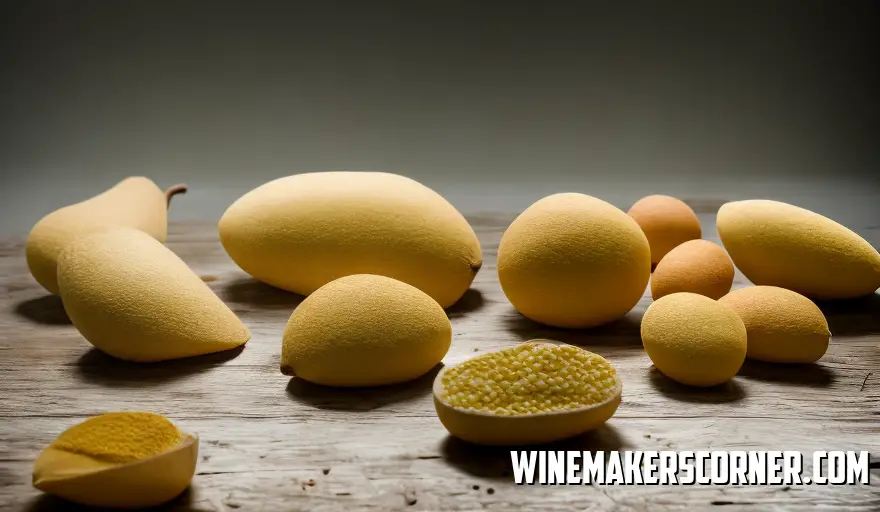The captivating world of wine takes us on a sensory voyage through tastes and smells like no other beverage can do.
However, there are secrets behind its crystal-clear appearance that are worth exploring. Join me on an adventurous expedition as we dive deep into the fascinating realm of wine clarification to uncover essential techniques that refine your favorite drink, from murky grape juice to a pristine masterpiece for your palate.
Discover fining agents, filtration methods, vegan-friendly alternatives, and everything else that goes into crafting that perfect glass of wine.
Table of Contents
Understanding Wine Clarification
Wine lovers rejoice! That beautiful clarity in your glass of vino isn’t an accident – it’s due to the essential process called wine clarification that ensures only the finest wines boast exquisite transparency. Let’s uncover this mystery together. The journey begins with grape juice post-fermentation – it appears cloudy and filled with suspended particles that must be removed for an elegant appearance.
Enter wine clarification: an artful technique winemakers use to achieve this desired result. Fining agents are used first; substances like casein (found in milk), egg whites, or gelatin expertly attract and bind microscopic impurities for removal. Then comes racking – a careful step where winemakers transfer the liquid between barrels or tanks multiple times to leave behind any sediments.
This process yields a more transparent liquid, but more must be done! Filtration is another critical aspect of wine clarification, using a pad or cross-flow filtration to remove any remaining solids. The result is the crystal clarity we adore in our glasses of fine wine. In addition to other methods, cold stabilization is vital in clarifying wines.
It involves exposing the wine to low temperatures for several weeks, forming and separating tartrate crystals from the solution, and removing unsightly haze. The aging process is equally crucial and is often underestimated. Wine left to age for months or even years allows natural sedimentation resulting in better-quality wines with enhanced flavors and aromas.
In short, wine clarification requires patience and precision – a captivating journey that turns simple grape juice into clear elixirs we all love. As you enjoy your next glass of exceptional wine, remember the complicated winemaking techniques involved in making such a masterpiece – cheers!
The Role of Fining Agents
If you’re a fan of crystal precise wines, you owe it all to fining agents! These secret ingredients play a vital role in removing impurities from the wine and improving its clarity. In essence, they work by binding together tiny particles suspended in the liquid so they can be easily separated from it. Some popular options include egg whites and gelatin – gentle yet effective choices that won’t alter taste or aroma – while others might surprise you! For instance, fish swim bladders (isinglass) are prized for their exceptional clarifying powers without sacrificing flavor profiles; bentonite clay works wonders for vegan-friendly wines thanks to its ability to swell upon contact with water.
Consumers no longer need to rely on animal-derived fining agents thanks to modern advances in winemaking technology like PVPP – a versatile polymer capable of tackling even the most stubborn tannins and phenolic compounds.
But controversy remains around the use of these agents. Some argue that over-fining can rob wines of their unique flavors and complexities, while others worry about hidden allergens.
This has led some winemakers to embrace noninterventionist or natural sedimentation techniques that take advantage of gravity’s slow but steady effects on suspended particles. While fining agents play an essential role in wine clarification, they must be wielded carefully to preserve their nuanced qualities. Wine enthusiasts must tread the fine line between innovation and tradition with respect and reverence for each precious drop of liquid gold.
Traditional vs. Modern Clarification Techniques
Discussion about wine clarification techniques has been raging for years; some connoisseurs swear by traditional methods while others champion modern approaches. This article investigates these methods’ differences and highlights their strengths and drawbacks. Before technology took over the winemaking, entirely natural processes were used for clarification; one such method was sedimentation, whereby suspended particles would eventually settle down over time.
Though this was time-consuming, it produced beautiful tranquil wines that shone bright and clear. Another age-old practice is fining – using agents like egg whites or bentonite clay, which bind with impurities and encourage settling. In recent times winemakers have adopted more efficient ways of clarifying their beverages by relying on cutting-edge technology rather than patience; filtration, a prime example, involves passing the liquid through membranes or screens that filter out particulates quickly, resulting in crystal precise wines with minimal fuss. However, this method risks stripping away pleasing aromas and delicate flavors, contributing to a wine’s overall complexity and allure.
Using enzymes is another modern way to clarify wine effectively. With their ability to break down proteins and other compounds that cause cloudiness in wine, these catalysts provide a simple yet efficient solution without altering the taste or bouquet of the final product – though some may question how much intervention should be allowed in winemaking practices. Cold stabilization is also commonly used nowadays; by chilling wines before bottling, tartrate crystals are encouraged to form and precipitate out, lowering the risk of crystal formation later on but requiring substantial energy use.
Ultimately, it comes down to individual preferences – whether one prefers time-honored methods or innovative techniques that ensure consistency in every batch produced. Still, traditional and modern methods provide advantages when creating flawlessly clear wines worthy of discerning collectors’ shelves. As advancements push winemaking boundaries toward discoveries, the future looks bright for this ever-evolving industry. Cheers!
Decoding Common Clarifying Agents
Clarifying agents are integral to fine winemaking, impacting taste and appearance – knowledge about them is essential. In this article, we examine some common approaches applied by vintners today.
Bentonite is a popular method favored by many winemakers due to its ability to fine-tune efficiently as it blends with small particles like proteins, thus bringing clarity and stability to wine production while remaining natural in origin – a great combo!
Isinglass provides another option as it binds with suspended sediment and particles creating larger clumps making it easier to filter out when producing white wines. It has been used since ancient times but maybe not be well-known among modern connoisseurs.
The use of egg whites as a traditional clarifying agent shouldn’t be overlooked either; they contain albumin, which can help to soften the harsh tannins of red wines. This age-old method still impacts today and isn’t going anywhere! The result of clarifying agents in the winemaking process is a smoother mouthfeel and a more refined taste profile. Handling these agents carefully is essential to prevent spoilage or unwanted flavors. For those seeking an animal-based fining agent, gelatin is derived from animal collagen and removes tannins and proteins from red and white wines.
However, vegetarians and vegans may have concerns about consuming wine treated with gelatin. Fortunately, there’s another option available – pea protein – which provides a plant-based alternative for removing haze-forming proteins without significantly compromising flavor or aroma profiles. Understanding common clarifying agents can help wine enthusiasts understand what makes their favorite beverages clear and stable! Each type of agent offers distinct advantages depending on the desired outcome – whether it be enhancing flavor profiles or accommodating specific dietary preferences.
Exploring Vegan-Friendly Alternatives
As veganism becomes more popular by the day, it’s no surprise that this lifestyle choice has made its way into the world of wine. Understanding how wine clarification works is critical for those who want to enjoy a vegan-friendly vino. After all, this process is vital for achieving crystal-precise wines – but it often involves animal-derived substances unsuitable for vegans. Luckily modern winemakers are rising to the challenge with innovative plant-based alternatives to traditional fining agents like gelatin or egg whites.
Bentonite clay and activated charcoal have revolutionized the industry by offering practical ways to remove impurities from wine without relying on animal products. Bentonite clay absorbs proteins and other unwanted compounds from the liquid. At the same time, activated charcoal adsorbs them without affecting flavor or scent – making these vegan-friendly fining agents a game changer for wine lovers looking to avoid animal-derived ingredients. And with cutting-edge filtration technologies like cross-flow filters also entering the scene, producing vegan wine has never been easier! Eliminating sediment and haze from wine without animal-based products is possible using ceramic membranes with minuscule pores. Furthermore, natural enzymes like pectinase offer a promising solution for vegan winemakers seeking to produce high-quality wines without compromising clarity or taste profiles.
Pectins are broken down into simpler components, resulting in more apparent wines while maintaining their original flavors intact.
Overall embracing these new techniques allows us to address ethical concerns while catering to a growing demand for vegan-friendly options among today’s consumers.
The Impact on Wine Flavor and Mouthfeel
Wine enthusiasts who seek out the ultimate taste experience often find themselves fascinated by the complex world of winemaking – especially when understanding how wine clarification plays an important role. This process seeks to remove unwanted particles from the liquid, such as proteins, dead yeast cells, and other organic matter, producing a clear beverage that tastes amazing and is visually stunning.
The impact on flavor cannot be overstated since its multi-faceted. Among its benefits is enhancing a wine’s aroma profile, which significantly contributes to overall enjoyment during tasting sessions. By removing compounds that may distract from subtle flavors in specific grape varietals, we allow those notes to come through with greater clarity than before, resulting in an unforgettable taste experience for all involved! Finally – no gritty mouthfeel here, thanks to proper clarification techniques! One of the most amazing things about tasting wine is how smooth it feels as it rolls over our tongues. But not all wines are made equal when getting rid of impurities.
Depending on whether they use bentonite or egg whites, specific filtration methods can change how a wine tastes and feels in your mouth entirely differently from others. Balancing clarity with character requires real finesse from the winemakers themselves! If you want to appreciate great vintages for everything they offer, never overlook the clarification process! It plays an enormous role in determining flavor and mouthfeel – two essential ingredients for the perfect sip.
Home Winemaking: DIY Clarification Tips
Wine clarification remains a mysterious yet pivotal part of the winemaking process. Whether you’re an expert or a home winemaker, understanding this step is crucial for producing wines with optimal clarity and taste. In this article, we’ll share some DIY tips for clarifying your wine at home.
To begin with, wine clarification refers to removing suspended particles that can cause cloudiness in your final product. This step is essential if you want your wine to look visually appealing and have enhanced flavor and aroma profiles. One popular method involves using fining agents such as bentonite clay or egg whites that bind to unwanted particles causing them to settle at the bottom of your container through precipitation.
However, be patient! Allow ample time for sedimentation before moving on. Another method worth trying involves racking: carefully siphoning clear wine from settled sediment into a fresh container without disrupting the lees at the bottom. Remember that precision is key in this process. For those looking to refine their homemade wines, investing in a wine filter system could be an excellent choice.
These systems push unclarified wine through a fine mesh or membrane that captures impurities, yielding an impressively clear final product. While less essential for casual home winemakers who brew small amounts for personal consumption or gifting purposes, investing in this technology is highly recommended if you aim for professional-grade results with every batch produced at home. In addition to filtration techniques, don’t forget about cold stabilization – especially when making white wines! By chilling your fermenting vessel to around 40°F for several weeks before bottling, you can expect tartaric acid crystals (aka “wine diamonds”) to form and settle out of the solution gradually.
Don’t stress about achieving precise wine batches at home – various techniques, from essential fining agents to cutting-edge filters, are available to meet your needs and budget. With some patience and practice, you can join the ranks of accomplished home winemakers. So get started today – cheers to happy winemaking!
Wine Allergies and Clarification
Wine lovers who struggle with allergic reactions might want to explore how wine clarification could help enhance their experience. By gaining knowledge about this process, connoisseurs can seek out allergen-free options without compromising taste. Wine allergies can originate from various components within the beverage, such as sulfites, histamines, and proteins; however, its protein content often causes issues for those with sensitivities.
Through removing impurities and targeting unwanted particles like tannins and proteins in particular, wine clarification holds potential promise in reducing allergy symptoms for sensitive drinkers. Standard techniques rely on fining agents (e.g., egg whites or gelatin), which bind with problematic substances before filtration or sedimentation commences; however, alternatives, such as bentonite clay, may be preferable for vegans or individuals with specific allergies. It’s worth noting that some winemakers may not employ such extensive clarification methods.
Selecting a bottle of wine can be challenging for those with allergies who may need to consider potential allergens like proteins in natural and unfiltered varieties. However, technology has brought forth new alternatives for clarifying eco-friendly and efficient wine. Electrodialysis is one such method that helps remove charged particles from the liquid without adding any potentially harmful substances into the mix.
By staying informed about how various clarification techniques affect wine allergen levels, individuals with sensitivities can continue enjoying their love for this exquisite drink without concerns over discomfort or reactions.




